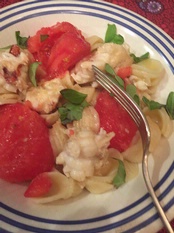It’s as if our taste buds know that with the Gulf of Maine warming up lobster season will soon peak. We live a fairly long distance from Maine, but because  lobster is readily available at our farmers’ market, we were able to easily satisfy our sudden yearning for Homarus americanus.
lobster is readily available at our farmers’ market, we were able to easily satisfy our sudden yearning for Homarus americanus.
Since there would be only two of us for dinner we decided that instead of buying an entire lobster (or two), a couple of lobster tails would be less expensive and also relatively simple to prepare, especially if we poached them in a rich, buttery sauce and tucked them into a bowlful of pasta.
Pasta and Butter-Poached Lobster
Serves 2
2 lobster tails
1/2 cup white wine
2 tablespoons minced shallot
1/2 cup (1/2 stick) cold salted butter
About 8 ounces pasta (we used orchiette)
1 teaspoon shredded lemon zest
1/8 teaspoon red pepper flakes (or cayenne, to taste)
2 large or 3 medium tomatoes, quartered
4-6 fresh basil leaves torn or cut into rough pieces
olive oil (optional)
If the lobster tails are frozen, thaw them by placing them in cold water for 30 minutes or so. Using sharp kitchen shears cut the shells away from the lobster flesh (if you aren’t sure how to do this there are numerous videos online demonstrating the best technique). Cut the flesh into bite size pieces.
Place the white wine and shallots in a medium saucepan and reduce over high heat to about 2 inches. Meanwhile, cook the pasta.
Cut the butter into six pieces. Over very low heat, whisk the butter, piece by piece, into the reduced wine mixture. Do not let it boil. Continue whisking until all the butter has been absorbed. Stir the lemon zest, red pepper flakes and lobster pieces into the mixture and cook over low heat, stirring frequently, for about 5-8 minutes, or until the lobster is white throughout.
Drain the pasta and divide it between two bowls. Top each one with the pieces of lobster and most of the butter sauce. Add the tomatoes to the pan the lobster cooked in and warm them, pressing down to release some of their juice; then add them and the rest of the pan juices to the bowls of pasta. Garnish each dish with basil. If, like us, you believe that everything tastes better with a little olive oil, drizzle a small amount of it over each dish.
This dish works best with white or substantial rosé wines, and our tasting indicated that the richer the wine, the better the pairing will turn out to be. Chardonnay is an obvious choice, and three of the wines we are recommending are made with that ubiquitous grape. Other strong possibilities include Pinot Gris, white Rhône varieties, Viognier, and of course bubbly. Don’t look for delicacy. Instead, go for exuberance.
More recipes and wine pairings: Wine With…
|
Selection
|
Approx. Price |
Comments |
|
Domaine Cheveau, Mâcon Fuissé (France) “Les Grandes Bruyeres” 2015 (Imported by Neil Rosenthal)
|
$21 |
Showing scant evidence of oak but nevertheless overflowing with ripe flavor, this Mâcon is made with Chardonnay but tastes unmistakably French. It offers a distinct streak of minerality in addition to its juicy autumnal fruit flavors. now. |
|
Migration, Santa Maria Valley (California) Chardonnay 2015
|
$55 |
Impeccably balanced and harmonious, with a lush texture and plenty of juicy fruit, this wine married seamlessly with the rich lobster in the dish. It’s by far the best Chardonnay we’ve yet tasted from Migration.
|
|
Simonsig, Stellenbosch (South Africa) Chenin Blanc 2017 (Imported by Quintessential)
|
$18 |
Vivacious, with plenty of pear-scented fruit and vibrant acidity for balance, this wine refreshes as it delights. It worked especially well with the tomatoes in the dish. |
|
Steele, Lake County (California) Viognier 2016
|
$19
|
Very true to the variety, with a floral bouquet and summer stone-fruit flavors, this is a rich wine that, unlike many California renditions, never seems excessive. Given the reasonable price tag, it offers fine value.
|
|
Viña Cobos, Lujan de Cuyo (Argentina) Chardonnay “Bramare” (Imported by Paul Hobbs Selections)
|
$27 |
Showing plenty of toasty oak, this wine impressed much more with the dish than when sipped on its own. The wood, ripe fruit, and succulent mouth-feel all worked wonderfully with the equally rich dish, the buttery sauce being very much in synergy with the wine. |
